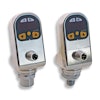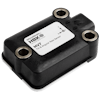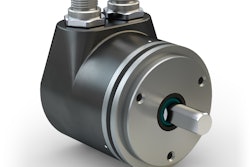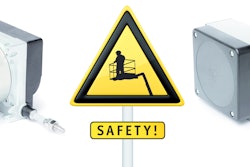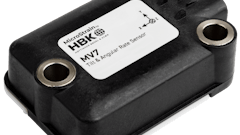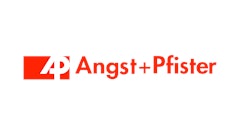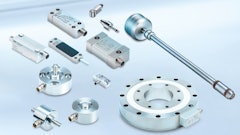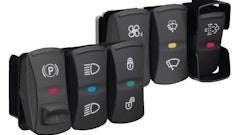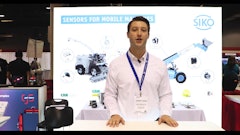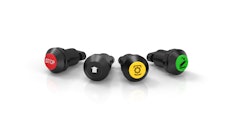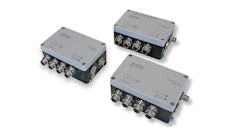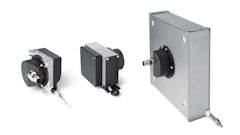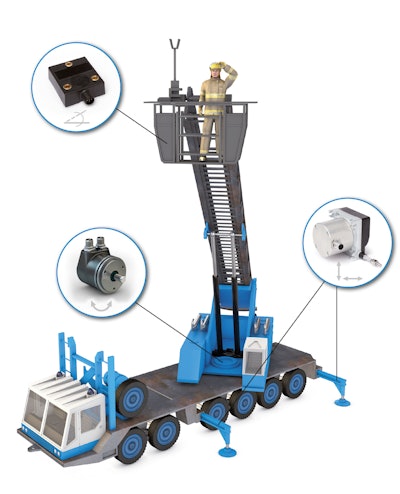
Whether in mobile cranes, vehicle- or truck-mounted cranes, intelligent sensors are nowadays indispensable for this entire range of equipment. Accurate detection of the support jack, the angle of the slewing ring, the angle of the overall vehicle, the installation angle of the booms and the exact position of the winch are becoming an integral part of intelligent mobile cranes. But these systems are not only used to meet the requirements of EN ISO 13849 or EN 13000 to comply with the safety directives and therefore ensure the vehicle's stability. For some time, these sensors have also been used to significantly increase the efficiency and performance of mobile cranes in commercial vehicles.
Through many years of experience in this area, SIKO GmbH has developed a complete system of sensor components for exactly these types of vehicles in order to not only make cranes safer for use, but also to maximize the efficiency and performance of each crane. With sensors designed specifically for use in cranes, crane manufacturers have the option of intelligently networking their crane in order to increase performance.
Variable support position thanks to wire-actuated encoders
The working environment at construction sites is often imperfect and confined. In many cases, the supports of mobile cranes cannot be fully extended and the crane is thereby limited in its use. It may be the case that the mobile crane must be placed at the site in a way that limits the support width to only 60%. In this case of limited installation space, a crane without active support monitoring only allows the crane to be supported at half the support length on both sides, for example. Thus, a large range of its actual performance spectrum is lost.
In order to prevent exactly this type of loss, it is important to be able to precisely detect the position of each support jack at all times. SIKO relies on wire-actuated encoders with a very high degree of robustness. Using draw-wire sensors in the support jacks allows for the position of every jack to be continuously monitored and forwarded to the machine control system. This information enables the machine control system to extend each support jack of the crane to the maximum possible reach allowed by the location.
This means the supports can be variably extended, e.g., they can be fully retracted on one side of the crane while being fully extended on the other side. When comparing an old crane to a new crane and based on having half the support base, thanks to the sensors from SIKO it is possible to achieve a significantly better reach into the desired direction before the load torque limitation switches off the crane's movement.
For this application, SIKO has been continuously developing draw-wire sensors over the last 30 years hand-in-hand with its customers in order to meet the demands of the harsh environment of mobile cranes and to achieve an increase in performance for the customer. Furthermore, the durable structure of the sensors is even more impressive, especially for mobile applications. For example, the spring assembly is protected against the ingress of dirt and water and always works perfectly even at temperatures below freezing.
Redundant length measuring systems for optimal safety
In recent years, increasingly safe wire-actuated encoders were developed based on changing standards. The safety assessment has increased considerably especially for mobile cranes, not just since the new draft of EN 13000. The SIKO wire-actuated encoders SG32, SG42, and SG62 offer this improved safety by means of a special and complete redundant sensor technology, which is employed to measure the absolute position. Two completely separate sensor systems detect the exact position and display them separately as analog signals. With measuring lengths between 3 and 6 m, these sensors are ideally suited to accurately determine the position of outriggers on cranes and working platforms as well as for determining the position of booms. In combination with safe control systems, the wire-actuated encoders allow the overall system to be certified pursuant to SIL2 PLd. With MTBF values of >100 years, these sensors are optimally suited for use in certified complete systems.
To use digital interfaces, products with CANopen with a simple or redundant design, SAE J1939, or the CANopen safety interface are available. This gives the customer the option to choose from a variety of wire-draw mechanisms. The most diverse of sizes are available with lengths between 1 and 15 m. Thanks to the flexible SIKO attachment system, the wire-actuated encoders can be factory-fitted with the desired field bus interface.
Accurate detection of slewing ring position
Another important point in the overall system is the deflection of the crane. The position of the slewing ring is an important factor for the load moment limit, which must be taken into account to calculate the tilting line, in addition to the correct jacking width. In order to detect the position of the slewing ring continuously and safely, it is important to use an absolute encoder for this. With the rotary encoder from SIKO, which was designed specifically for this application, special attention was given to the encoder's adaptation to the slewing ring. Thus, the shaft load capacity of these encoders has been increased. Furthermore, optional form-fitting and spring-loaded external gears are mounted for use on slewing rings. These serve to compensate for the backlash of the slewing ring to the external gear, thus always providing accurate position sensing.
Another important point is the conversion of the absolute position of the rotary encoder in relation to the real position of the slewing ring. Because the encoder is connected to the slewing ring via an external gear and the transmission ratio is usually an uneven or odd number of transmissions, the conversion to a 0-360 degree value is not always easy for the machine manufacturer. This is because the position of the slewing ring should always be resolved in 360 degrees, no matter how often the slewing ring turns in one direction and even if the rotary encoder exceeds its internal zero point after 4,096 revolutions. SIKO has implemented a special software in the new WV58MR rotary encoder for this purpose which relieving the programmer of the machine of this problem. This software allows you to configure the number of teeth of the slewing ring and the number of teeth of the external gear in the rotary encoder. This enables virtually any transmission to be generated. Thus the rotary encoder outputs the exact position of the slewing ring via the interface as well as its speed and thus relieves the machine manufacturer from having to recalculate the position. However, this solution does not only provide a simplification for implementation. Thanks to this software, the encoder is easy to implement into vastly different machines. No matter how big the slewing ring is, the same encoder system can be used in all cases. The machine manufacturer can thus reduce the number of variants, resulting in fewer individual parts and different encoders being necessary, which therefore saves money.
Another important aspect is selecting the right interface. In order to ensure the customer maximum flexibility in this regard, the slewing ring encoders are available with all standard interfaces. Depending on the application, the customer can choose between analog outputs, CANopen, or SAE J1939 interface. A redundant version of the slewing ring encoder is available with a redundant CANopen interface or CANopen Safety. Well-rounded all around.
Away from the sun - detecting the installation angle of the telescopic boom
A further important factor to realize the optimum performance range of the crane is provided by an additional encoder of the SIKO sensor system for mobile cranes. As soon as the telescopic boom is extending skywards, the load torque limiter must detect the exact installation angle of the boom. For this too, the single-turn version of the redundant rotary encoder WV58MR from SIKO is used on the swivel joints of the telescope. Extremely robust and resistant to environmental influences, it withstands the harshest weather conditions. With protection class IP67, a wide temperature range of -40-85 C (-40-185 F), and a special protective coating, it is perfectly suited for mobile machines. By simple adaptation of the rotary encoder, it can detect the exact installation angle directly on the boom and forward this information via the interface.
The cable drum in the boom system is also taken into account. So-called winch-encoders ensure safety for this and feed the control system and safety system of the drum with information. The winch encoder is directly, positively coupled with the suspension rope drum and records the length of the suspension rope as well as its direction and speed. The rotary encoder permanently monitors the function of the suspension rope drum through the position and speed limit values, which can be configured internally. If the speed limit is exceeded or a limit position is violated, the two internal sensor systems report this automatically through emergency messages via bus signals to the controller or the safety system of the suspension rope drum.
Always on a firm footing
In order to always ensure a firm footing, it is important to know (in addition to the mentioned angle and path) whether or not the vehicle inclination even permits the load under the relevant conditions. In order to properly detect the angle of the vehicle to the ground, SIKO takes advantage of a simple natural feature. Gravity.
The sensor uses gravity to detect positions with a system accuracy of +/- 0.1 degree in the range up to 360 degrees. The micro-electromechanical measuring systems (MEMS) within the sensor detect the precise orientation of the vehicle to the ground. An IK360 inclinometer as a single-axis version (0-360 degrees) or as a two-axle version (+/- 80 degrees) are available for this. The compact IK360 is also characterized by quick, uncomplicated, and error-free installation through three-point mounting. In addition, the small tilt sensor impresses with its high protection class IP69K. This means the fully encapsulated sensor can also be mounted in the undercarriage and can deal with water and dirt in any situation.
Performance increase in the system
Through the examples described above, it becomes clear that information that is made available by intelligent sensor systems not only increase the safety of mobile cranes, but also their efficiency and performance.
Through this, permissible workloads can be calculated directly in the crane control system and continuously updated in real-time during crane movements. Intelligent and efficient linking of these values helps to calculate the tilting edge, the current center of gravity of the crane with load. But the control system and the safety-related load torque limiter are not the only ones to profit from this. The collected information can be made available to the crane operator, which can make his work much easier in and on the crane. Accidents caused by incorrect operation can be avoided both during setup and when lifting loads.
Through this new flexibility, dispatchers can better plan the deployment of their vehicles to construction sites and thus use the vehicles more efficiently. So the end user benefits directly, not only through improved safety, but also through a higher load capacity and a larger work area when using the crane.
